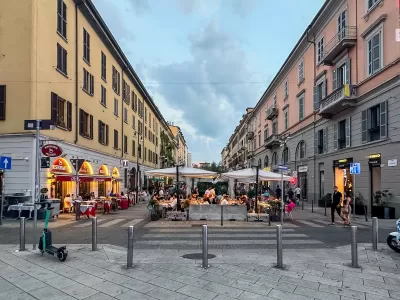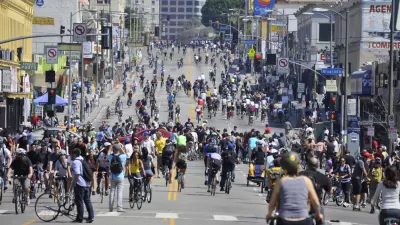The Covid era highlighted social inequities and prompted new paradigms for urbanism and mobility. Will they stick around?

How will urban design and mobility change in the post-COVID city? Scott Shepard shares his thoughts, noting that “After the initial shock and subsequent waves [of the pandemic], a new way of thinking began to quickly take hold.”
Cities around the country and the world began looking for ways to reverse decades- and centuries-old urban design paradigms, spurred both by changes wrought by the pandemic and by the threats of climate change. “This, along with public policies and investments in shared and active modes and a decarbonization of the transport sector collectively pointed towards a brighter future, and one decoupled from the 20th century modernist, car centric urban paradigm.”
Shepard sees promise in the reorganization of society forced by the pandemic and the changes that are persisting as the pandemic winds down. “Much is still needed to be done to help promote and develop in this manner, such as the 15 Minute City and new initiatives to help people take back control of public spaces from the automobile through tactical urbanism and DIY projects. However, this unprecedented era we live in is cause for celebration of our cities, and the potential they bring to a better quality of life for all groups and communities.”
FULL STORY: Urbanism & Mobility in the Post-COVID City

Manufactured Crisis: Losing the Nation’s Largest Source of Unsubsidized Affordable Housing
Manufactured housing communities have long been an affordable housing option for millions of people living in the U.S., but that affordability is disappearing rapidly. How did we get here?

Americans May Be Stuck — But Why?
Americans are moving a lot less than they once did, and that is a problem. While Yoni Applebaum, in his highly-publicized article Stuck, gets the reasons badly wrong, it's still important to ask: why are we moving so much less than before?

Using Old Oil and Gas Wells for Green Energy Storage
Penn State researchers have found that repurposing abandoned oil and gas wells for geothermal-assisted compressed-air energy storage can boost efficiency, reduce environmental risks, and support clean energy and job transitions.

Minneapolis Bans Rent-Setting Software
Four cities have enacted restrictions on algorithmic software that can inflate rent costs.

Oakland to Add 244 New EV Chargers
Oakland plans to launch its new charging network at eight locations by the end of 2025.

Jane Goodall Inspires with Message of Hope, Resilience, and Environmental Action
Speaking in Pasadena, Jane Goodall offered a hopeful and inspirational message, urging global compassion, environmental responsibility, and the power of individual action to shape a better future.
Urban Design for Planners 1: Software Tools
This six-course series explores essential urban design concepts using open source software and equips planners with the tools they need to participate fully in the urban design process.
Planning for Universal Design
Learn the tools for implementing Universal Design in planning regulations.
Heyer Gruel & Associates PA
City of Moreno Valley
Institute for Housing and Urban Development Studies (IHS)
City of Grandview
Harvard GSD Executive Education
Salt Lake City
NYU Wagner Graduate School of Public Service
City of Cambridge, Maryland



























